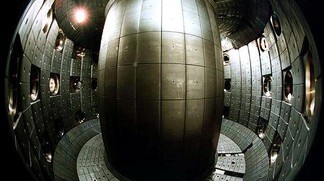Controlling nuclear fusion instabilities
January 19, 2012
École Polytechnique Fédérale de Lausanne (EPFL) physicists have succeeded for the first time in preventing the development of instabilities in a nuclear fusion reactor. It’s an important step forward in the effort to build the ITER fusion reactor, currently in development in Southern France.
Nuclear fusion is an attempt to reproduce the energy of the Sun in an Earth-based reactor system. When gas is heated to several million degrees, it becomes plasma.
Sometimes in the plasma, an instability will appear and grow large enough to perturb the plasma, making it vibrate despite the presence of the magnetic field in which it is contained. If the plasma touches the walls of the reactor, it will cool rapidly and create large electromagnetic forces within the structure of the machine.
The challenge is to reduce the instabilities deep within in the interior of the plasma so that they don’t amplify, while at the same time allowing the reactor to continue to function normally.
By adjusting an antenna that emits electromagnetic radiation, Jonathan Graves and his colleagues from EPFL’s Center for Research in Plasma Physics were able to quench the instabilities when they appear, in the precise region where they are forming, and without perturbing the rest of the installation.
The beauty of their approach is that they were able to use antennas that are used as part of the system to heat the plasma, and that are already present in the Joint European Torus (JET), the largest reactor currently in use. Surprisingly, the simulations and the tests showed that heating and instability suppression can be combined, by aiming the radiation slightly off-center in the plasma.
The next step will be to add a detector system that will make it possible to neutralize instabilities in real time over longer time periods.
Ref.: J.P. Graves et al., Control of magnetohydrodynamic stability by phase space engineering of energetic ions in tokamak plasmas, Nature Communications, 2012 [DOI: 10.1038/ncomms1622]
